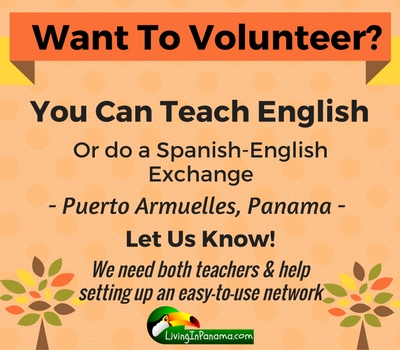
Or possibly an English-Spanish exchange network.
It would be a way for expat retirees to help young people in Puerto Armuelles improve their English.
As you can imagine, there are many more job and business opportunities open to Panamanians who speak English. It literally opens many doors for them here and internationally.
In Panama, where there is a wide gap between the upper class and the poor, helping a young person of modest means to improve their English skills might be the jumpstart they need to launch them, and their family, from the lower class into Panama’s growing middle class.
You really can make a difference in your world by volunteering to help another person. It is a satisfying way to maintain a grateful heart.
Not only is volunteering is a great way for expats to mix with locals, it is a an ideal way to practice your Spanish. And, of course, there is always the possibility of working out a trade: English lessons for Spanish lessons.
What’s more, you just might make a new friend for life. Who knows?
I am trying to get a rough idea of how many of our readers might be interested in participating in a language volunteer, or language exchange project. If you know someone who may be interested in volunteering, please let them know about our idea.
Is there anyone with a great organizational gift who would like to help with the logistics of setting up an easy-to-use system?
Please let us know. Send us an email, use our contact page, or comment below.
We welcome your suggestions, since this is new territory for us.
Thanks.
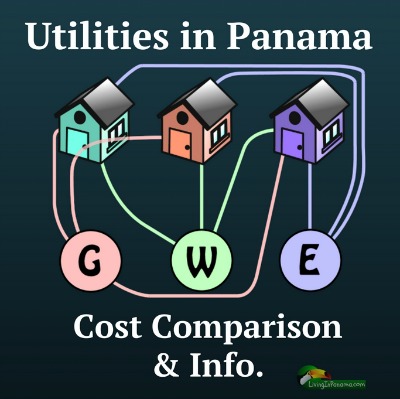
First of all, bill paying in Puerto Armuelles has not been a big preoccupation for us.
Bills here are so much lower than they are back in Seattle.
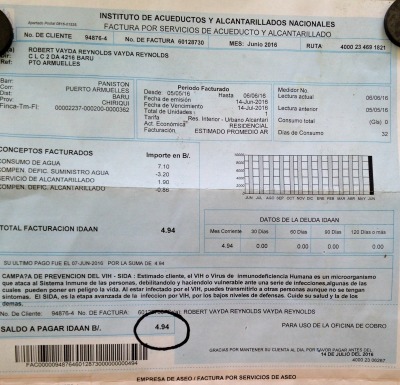
As you can see from the photo of the water bill (Instituto de Acueductos y Acantarillados or IDAAN), our water bill for June was $4.94, for unlimited water use.
By comparison, our water bill in Seattle is typically $150 per month in the winter, and up to $250 in summer. In Seattle, they charge you for the water both going in and going out of your house.
Our electricity bill in Puerto Armuelles is typically $35 per month. In Seattle, our summer electricity bill is about $300. Our highest winter bill was over $450 (we have electric heating).
We do not have air conditioning, but we are heavy users of fans and have a big and old refrigerator. We also have children who never remember to turn off a fan or light they are not using(!) You can see our electric bill below. Click on it to make it larger.
I looked up the electric rates in Seattle and Panama City to get a better comparison. 2 big cities.
Electricity in Panama has 3 rates, depending upon your use.
If you use less than 300 kWh, your rate is subsidized. Which is how some people have monthly electricity bills of only $4. If you use between 300- 750 kWh, you pay at a higher rate. If you use more than 750kWh, you pay at the highest rate. I couldn't figure out what that rate was, but that is the breakdown per kWh.
From conversations and reading, it seems clear that the rate charged at each of those kWh levels varies across the country.
Maybe it has something to do with whether your area is covered by Union Fenosa vs. Gas Natural Fenosa vs. the 2 electrical distributors (Empresa de Distribución Eléctrica Metro Oeste (Edemet), and Empresa de Distribución Eléctrica Chiriquí (Edechi) vs. Enca, which serves the northeast area of Panama
Gas Natural Fenosa of Spain is in charge of almost all the electricity in Panama though. Gas Natural Fenosa merged with Union Fenosa in 2009 and since then they bought 51% of the electricity distributors Edemet and Edechi. And they keep expanding. Perhaps all these subsidiaries and companies maintain separate rate structures? In Puerto Armuelles, the electricity bill (above) is issued by Gas Natural Fenosa, although everyone refers to it as Union Fenosa.
In general, if you use A/C all day every day, your electricity bill will likely be close to $300/month. If you use your A/C less, say just in your bedroom, your electricity bill will be more in the $100 to $150/month range.
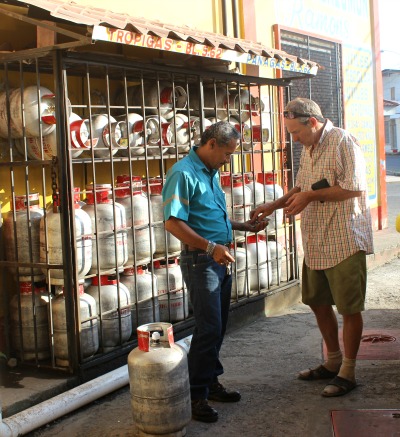
Our gas bill in Seattle is around $100/month. Here in Puerto, where there are no in-ground gas pipes, our bottled gas bill for our propane range/stovetop and our propane dryer is about $10/month. $5 a month for each bottle.
As you can see, compared to our costs in Seattle, we have substantial savings in our home utility bills in Puerto Armuelles.
Now for a question, I also get, "how to pay your utility bills in Panama". In that article about paying utility bills, I also give some information on a few other household bills such as

Loren rented a house in the Corazon de Jesus neighborhood of Puerto Armuelles for a few months.
She visited Puerto after spending over a year in Quito, Ecuador.
On her way out of town, Loren kindly wrote me about her experience and thoughts on living in Puerto Armuelles, Panama.
Since I am not within walking distance of downtown Puerto Armuelles, I take a taxi to and from the local market.
Shared Taxi Experience
Quite often when the driver stops for me, there are other passengers in the vehicle. The driver could just as easily pass me by, since he already has a fare. I especially appreciate his courtesy which gives me a chance to get out of the hot sun. This is quite a change from other places I have lived, where taxis pick up and deliver one fare at a time.
The interesting part of taking a shared taxi comes from discovering all the new places I get to see while we travel from Point A to Point B, which is often in the opposite direction from where I want to go. Along the way, we drop off the original passenger(s), perhaps pick up another passenger(s), then we might make an unscheduled stop for the driver.
Recently, I had one driver stop by his house to get more bottled water and on another occasion we first stopped by the driver's house so he could add water to his tank and fill the water dish for his chickens, lol!
This took about 5 minutes while I and another passenger waited in the car. Once that was done, we all headed to her destination and then back across town to my destination. So, for the same price, I get the Scenic Tour!
Everyone's Needs Are Equal & Respected
What this tells me is that this country respects the needs of all individuals. My need to get to the market is of no greater importance than the other passenger's need to meet her husband for lunch, nor greater in importance than the driver's need to take care of business at his home.
I like that about Puerto Armuelles ... there is the understanding that there is enough time for all things to get done and there is respect for all persons' needs.
Loren, thank you so much for sharing your thoughts on living in Puerto Armuelles.
If you want to share your experiences and views of Puerto Armuelles or Panama in general, please email them to me or use our contact form. We'd love to share your thoughts and experiences with others.
Or you can simply comment below.
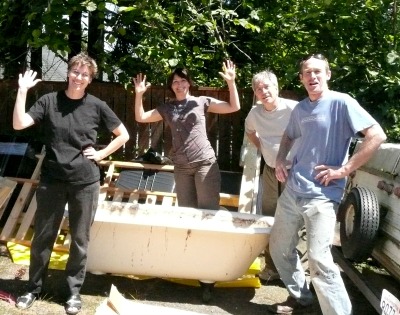
The critical thing is to decide what action you will take on each item - and then do it. It is important to make a list, set deadlines. And don't forget to delegate!
Below are the main items you will have to accomplish before you move. How you deal with them will depend upon your situation.
What you will do with your home depends upon how final you want your move overseas to be.
Do you want to be able to move back "home" in case Panama doesn't work out? Or perhaps you are only anticipating living in Panama for 5 years? Or maybe you simply want to keep your home available for month-long visits and rent it the rest of the year. Your plans will determine the answers to the questions below.
If You Own Your Home:
Will you sell it? If so, when?
Will you rent it? If so, will you manage the rental yourself or hire a property manager?
Yes, you can manage your own properties from abroad. We have done it for years. Of course, it depends upon the location of your home. The greater the demand for the type and location of your rental, the more likely you can successfully manage the rental yourself.
If you do rent your home out, make sure it is in good rental condition. Get all minor repairs done. Make a list of everything you left behind. Ideally, identify a good handyman to take care of any future maintenance issue.
If You Are A Renter:
As a renter, your options are more straight forward.
Give notice, per your lease.
Talk to your landlord about subletting it to someone else, if you want the option to come back
If you are in a lease, talk to your landlord about how break your lease without a penalty. For instance, find someone acceptable to your landlord to take over your lease,
There are many factors to consider when deciding what to do with your possessions. Some items you will bring simply because you love them. Somethings you will not bring because they won't survive your new tropical climate. You may decide you want to start all over and buy most everything you need in your new home.
These are the questions you will need to ask yourself.
What will you bring with you?
How will you bring it with you? (via container ship, via airplane in bins & suitcases...)
If shipping your belongings, research and secure a shipping service. As you pack, keep in mind that you will need to provide an itemized list of the contents. (I highly recommend making that list as you pack - don't rely on your memory.)
If you don’t have a place all ready to move into, what will you do with your possessions until you find a new home? (e.g., Are there any storage facilities where you are going?)
What will you do with your belongings you don’t bring with you?
Not all items do well in the tropics. Overstuffed furniture and leather items do not fare well in the tropics. Photographs and important papers must be kept well sealed. Otherwise, moisture will wreak havoc on them.
You might want to think 3 times about bringing important heirlooms. There is a reason that people who live in the tropics do not own multi-generational heirlooms. This is especially true for items are made of fabric, leather, or paper.
FYI, If you plan on living in a fully-sealed air conditioned home, your possessions will not be impacted by the tropical climate nearly as much.
Shipping your furniture overseas is an expensive option. It can also be a logistical nightmare. This is something to think about. Is it important to you to have your furniture from "home" in Panama?
Before you ship your furniture, go furniture shopping in Panama. Check out what kind of furniture is available. You may prefer to sell your stuff and buy new stuff in Panama. Your old furniture may not even fit in your new home. Something else is to consider buying used in Panama. You can check out craigslist in Panama as well as Facebook groups like Buy Sell Chiriqui.
Our short answer is "no". But there are exceptions.
You can learn more by reading my post on whether you should bring your car to Panama.
Also, for another perspective, you might want to check out what my friend Sheryl says about shipping her car (and her stuff) to Panama. Sheryl is thrilled she decided to ship her car to her new home in Puerto Armuelles, Panama.
If you aren't shipping your car, you may want to read our advice and experience buying used cars in Panama.
Electronics don't last as long in the tropics. As an example, I will describe why a non-electronic controlled fan is a better choice than an electronic controlled fan. There are 2 reasons for this.
I am not saying don't bring electronics. I couldn't live without them.
I have a whole section below on what electronic devices you should bring. I am only suggesting that you minimize the use of items that have electronic controls, when it is an option.
If you decide to store some of your belongings "back home", check out a fixed-term storage option. It is cheaper than the more common self-storage solution. You cannot visit your storage unit as freely and easily. But you won't have to since you'll be living in Panama.
The Goodwin family have written up some great tips on packing and moving overseas on their site. I have included many of their packing tips and some of my own below.
Pack your gear in plastic bins. Not only do plastic bins serve as sturdy shipping boxes, but once unpacked these can be used in your new home in various ways. They can be used as storage bins, end tables, foot stools, and more. Going to your local store and picking up bins in Panama, may not be as easy as it is "back home.
The Goodwins highly recommend using Sterilite Footlocker bins because they are both light-weight and sturdy. They zip-tied them closed for the journey. We also used bins as packing containers when we moved to Panama. I am still using them as storage bins for extra clothes, art supplies, and holiday decorations. We used Rubbermaid bins, but I think the Sterlite footlockers would have served us better.
Vacuum bags. Yes, use vacuum bags to make your stuff smaller. But remember, it won't make your things lighter. Something to keep in mind if you are trying to keep below that critical 50lb max for each suitcase or bin that you check in on the airplane.
Luggage scale. Speaking of that sweet 50lb mark, you may want to buy a luggage scale. If I knew they were so reasonably priced, I would have bought one years ago. I have been relying on my husband's great sense of weight. He can usually guess a suitcase's weight within half a pound. As he is not always available, I would prefer to use a scale. Check out this well-reviewed and inexpensive luggage scale.
Organizing baskets, bins & containers. Think about how you organize your possessions now. You probably use a variety of bins, baskets, containers for your clothing, jewelry, spices, and more. It is so much easier to set up your new home if you have those organizing items immediately available. If you have room to pack containers that will lay flat in your packing bins, you will be very happy. I wish that I had included alot more organizing bins. Ikea has a number of collapsible bins. You can also find bins on Amazon.
Collapsible wagon. The Goodwins have a fantastic tip for people with kids under 11 years old. They used a collapsible wagons as one of their free carry on “strollers”. Great to haul kids and carryon through the airport, as well as on the streets of your new town. It works best if you put a piece of plywood on the bottom. They used an Ozark folding wagon, but I think this wagon may be a better choice.
Relocating your pet involves a lot of paperwork and hoops to jump through. Given your moving to do list, I’d highly recommend using a service to guide you through this process. In Panama, PanamaPetRelocation.com is excellent.
You might want to check them out. I have also written about diy pet relocation.
Consider finding a new home for your pet. Not all animals will thrive in the tropics. You might want to start this process early so you can be sure to find a loving home for your pet.
Register a forwarding address with the post office (friend or family member, or mailing service)
Research and decide on a mailing service to use (Choose one that will scan your mail so you can read it online.)
Find an accountant who specializes in doing overseas taxes.
Of course, you can usually find an accountant in your new country that specializes in doing taxes for expats. There are a few good tax services in Panama. Make sure that they are comfortable doing your return without requiring that you visit their office. Be sure they can file all signatures and paperwork electronically.
You may want to ask your accountant these questions.
You can also do your taxes using online programs such as Turbotax. These days you can usually call all the institutions that send you tax statements and get necessary tax information by phone, or have it emailed to you. If you use a mailing service, you can request that they open and scan all your tax-related correspondence.
As always, keep all receipts. If your moving expenses are being paid for, this is especially important.
Make sure all outstanding bills are paid. Leave money and/or checks with a friend or relative to settle any bills that you may have missed.
Be sure that you will be able to do all your banking online. You are going to be managing your money online, so do a test before you leave.
Set up automatic bill payments with your banks and other entities (such as utility companies) for payments you will be making while you are away.
Get a direct phone number of your personal banker, at the branch where they know you. I have found having easy access to a bank manager who knows me well to be invaluable.
Ask how you can lower or eliminate bank ATM withdrawal fees while overseas
Inform financial institutions of your move (bank, credit cards, insurance, etc)
You going to need a lot of documents. Getting a visa, entering your child in school, getting married, and getting a driver's license will all require you to have various documents. These documents will often need to be stamped, translated and notarized.
Review the documents that are required for anything you can imagine needing to get done. Bring these with you.
Translations
Ideally, you should have all relevant documents translated and stamped by a notary. However, there are certified translators in Panama who can do legal translations. There are also online resources for translations; for instance, Languages International.
Documents You May Need
Get a Binder For Your Documents
But all these documents together in a binder with plastic sleeves. The plastic sleeves will protect your documents from humidity and coffee spills. It is a huge plus to have all your documents in one easy to locate blinder. However, it is wise to leave copies of everything with a trusted friend "back home" too.
When going to a government office to submit documents, bring the whole binder with you. An agency will often tell you all the items you need to submit to get whatever authorization you need. But once you arrive at their office, it is very common for them to suddenly remember about yet another required document. If you bring the binder, you will have whatever they need, saving you from making another trip.
Make Copies
As I've mentioned, be sure to make copies of all your documents. Give the copies away. Always keep the originals.
Research and purchase your health insurance. I discuss health insurance options for expats elsewhere on my site.
Find out what the local names or their equivalents, for any prescription medication you or your family are taking. Discover if they are available in Panama. If not, arrange to take a supply with you. Sometimes customs or security will ask to see proof that you need that medicine. Bring a document to show them.
As you consider your health insurance options, it is helpful to learn about the health care system in Panama. In this post I also discuss the system, types of health care insurance in Panama and how to decide which, if any, to use.
Leave someone you trust with copies of your important documents and access to your money to pay any forgotten about bills. Make a master list of passwords, bank information, online accounts, etc. Of course, you can also keep that information in the cloud somewhere, but sometimes you won't be able to get access to Internet.
Although, most things can be taken care of from overseas, sometimes having someone on the ground with all the needed information is a much better option. It is best to keep both options open.
You also may want to give someone you trust a power of attorney in your home country. You can make it both limited in scope and within a specific timeframe.
This is important. Electronics and Internet communication will be a much bigger part of your life in Panama. It is for me.
I count on MagicJack, Skype or Whatsapp to communicate with people back home. I can also use my Panama cell phone or land line, but it is much cheaper with MagicJack, Skype and Whatsapp.
Keep in mind, you can get power cords, chargers, and more that are higher quality much more readily and cheaper in the States.
Electronics To Bring
About Unlocked Cell Phones
Owning an unlocked cell phone will make your life much easier. I have 2 SIM cards. One for the States and one for Panama. I simply switch the card for the country I am in, but I keep all my contact and other information on my phone.
You can continue to use a long-term cell phone service in both countries. For along time we did not. In the US, we used SimpleMobile and MetroPC. You can also use a service that allows you to buy a specific amount of minutes for calls and texting, say $10. That is the way we have mostly done it while in Panama. We use Movistar cell service. You can buy service via card in $1 to $25 increments. We usually buy service $5 at a time. You can also subscribe to a monthly service. I currently subscribe to Movistar's monthly service for $17 a month, which includes Internet.
Elections in your country of origin can still impact your life overseas. You probably want to vote in those elections. You should find out what you need to do to vote from overseas before you move. For Americans, I wrote about how to vote from overseas in this post.
You will need to do some planning if you want to work in Panama. I wrote suggesting some ideas about working and earning money in Panama.
If you want to keep your job, find out if getting a transfer or working remotely is an option. If it is possible, talk with your boss as soon as you can. Be ready to explain exactly how and why working from Panama would be mutually beneficial.
If you plan to get an online job, it is best to get the training, and the job before you move. There are various customer service, medical transcription, and other legitimate jobs you can do via your computer from Panama. Jordan talks about how to teach English online while living in Panama.
Transitioning from the typical lifestyle in a first world country to Panama is simple, but there are many details that need your attention.
Think about all the various aspects of your life. Does anything need to be resolved or attended to before you move overseas? Add those items to your to do list.
My biggest advice is to relax.
Don't take your to-do list too seriously.
Although it is best if you think of everything and check it all off your to do list, the world won't end if you don't.
We were nowhere near as organized as we "should" have been when moving to Panama.
You can take care of alot of things once you are in Panama. Also, this is where a trusted friend or family can help. They can assist in doing all the things you forgot to do, or didn't have time to accomplish.
Prioritize & Slow Down
Focus on accomplishing the things that must be done by you, and only you, before you move.
It is time to get into the pace of life you will be living in Panama.
As someone who goes back and forth from the States to Panama, I much prefer the slower lifestyle of Panama. It is much more relaxing and humanizing. You might as well start enjoying that lower stress lifestyle now.
[leadplayer_vid id="579D1CD0E3480"]
Betsy: Hey, Milton.
Milton: Good morning.
Betsy: I was wondering if you could tell me why you decided to move and live in Puerto Armuelles?
Milton: It's such a beautiful place. It's very friendly. The people here are very friendly. It's just a warm environment.
The climate's great. Of course, the ocean is beautiful.
It's just a nice place to live, and it's an easy place to live.
Betsy: Do you have any advice to give people who are thinking about moving to Panama or to Puerto Armuelles?
Milton: Yeah, I would say come down and visit, rent a house, stay for six, seven months, a year.
If you really like it, then buy something. But you really wanna get in touch with your environment and what's going on in your community. Just to double check and make sure that this is gonna fit your lifestyle.
And when you come down, make sure you stay at Heavenly's Hotel. We'll treat you right.
Betsy: Anything else you wanna say to people who are thinking of moving to Puerto Armuelles or Panama?
Milton: Again, Panama has so many things to offer.
It's a very easy place to do the transfer. They use American dollars, which is very easy for expats.
Also, there's many Visa programs for you to become a Jubilado or you can become a friendly nation Visa. They'll pretty much welcome you in, which has a lot of benefits as well.
Betsy: Thank you very much, Milton.
Milton: You're welcome. Thank you.
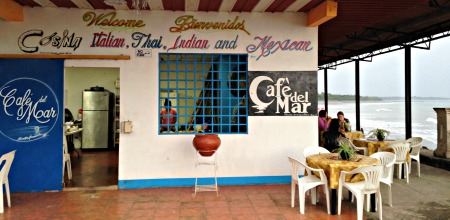
Puerto has a new waterfront restaurant, Cafe del Mar.
As the photo shows, it serves Italian, Thai, Indian and Mexican food, as well as hamburgers.
My family and I ate there after running into a couple who raved about it. They had been there 4 times in one week! And people have also told us they like the restaurant. Overwhelmingly people recommended ordering the dish Thai On On.
When we went the service was very courteous and prompt. We were served by the 2 owners Bernard and Ricardo. Bernard has lived in Puerto Armuelles for years. He is Iranian and speaks English well. Ricardo has had restaurants in both Bocas and David. He has minimal English. Both men are good hosts.
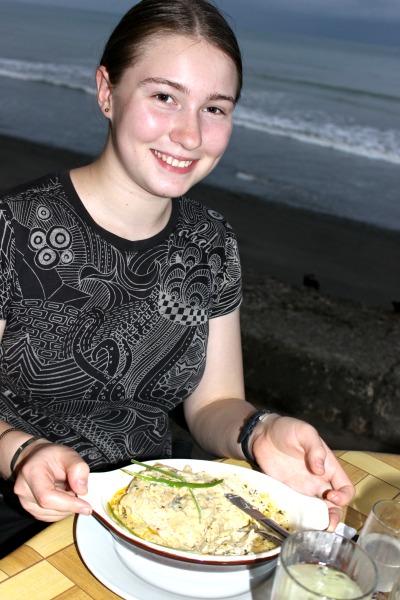
We ordered 2 dishes, the lasagne and, of course, the Thai dish, Thai One On. You can see what they looked like in the photos. Normally, the Thai dish is made with chicken or fish, but they were out of both and used ground beef instead. They asked us if that was okay first.
It was wonderful to have food with flavors you cannot get when eating out elsewhere in Puerto Armuelles. It was interesting that the Thai dish was in the form of a burrito, but it worked.
See their menu in the photos below.
We found our food greasier than we like, but that could be because of the substitution of ground beef for the usual chicken in our dish.
They emphasized that one of their specialities are liquado and batidos, similar to smoothies and milk shakes. But we didn't feel like having them a dinner.
Since then we have had their liquados (but not their batidos) many times. Ricardo makes them best. They only use natural fruit with no added sugar, which is wonderful. I have tried their mango, pineapple, and watermelon liquados. I like Mango the best. Others in my family favor watermelon. They don't always fruit in stock for all the flavors they offer. Some day soon we will have to try their chocolate batido.
The Cafe is open every day, except Tuesday. They usually open at 11, although occasionally not until 1pm. They are open for snacks, lunch, and dinner.
Cafe del Mar overlooks the water at Puerto Armuelles's downtown waterfront park. It is right next to the bus station. If you are at the park, looking at the water, the cafe is on your left.
We go to that park just to sit and watch the water a few times a week. So having a place to sip a liquado is a good plus. In fact, until about a year ago, there had been a small cafe that served liquado in the same location. It didn't offer much in the way of food and their liquados were very sweet. Cafe del Mar's liquados are far superior to those.
You can call Bernard to order take out or to pre-order - 6751-5028.
Business is good at Cafe del Mar. But both Ricardo and Bernard anticipate that their business will do even better once Del Monte comes to town. Del Monte will put more money in the pockets of everyone from banana pickers to management. That money will be spent all over town, including at Cafe del Mar.
If you haven't heard yet, Del Monte is nearing the end of a very long government process to allow Del Monte to produce bananas here. Del Monte will be taking over the old Chiquita Banana plantations. Read more about Del Monte growing bananas in Puerto Armuelles, Panama.

Before moving to Panama, I was already quite familiar with bamboo from my travels in Southeast Asia and while building houses in Japan.
In both Hong Kong and mainland China, I have seen bamboo scaffolding rising up 15, even 20 stories. In Indonesia, I've seen bamboo used for construction of airy pole buildings.
My only real bamboo construction experience has been with Tonkin cane from Vietnam. I still have some Tonkin cane stored along the side of my home in Seattle. It is left over from a fence I built 18 years ago.
Tonkin cane is solid, with literally no hollow core.
The bamboo has been stored outdoors in Seattle’s moist and mild climate for 18 years. It appears to have aged hardly at all. The fence that I built from this bamboo is in nearly the same good condition. Though it has been exposed to sun, rain, high and low temperatures for nearly two decades, I have only replaced a couple of canes in all those years.

We get plenty of rain and abundant sunshine here in Panama. It is an ideal combination for bamboo habitat. In fact, some of Panama's timber species grow 20 or 30 feet annually and can reach up to 8” in diameter.
In our town of Puerto Armuelles Panama, you can typically get timber bamboo 60 feet tall and 3”-5” in diameter (see photo).
The price is wonderfully affordable. A 60’ length of timber bamboo only costs ~$1.50. Unfortunately, you wouldn't want to use it to build your home.
This is because Panama's timber bamboo has a mostly hollow structure. Which mean it does not last long when used as the exterior of structures.
Most bamboo that I have encountered in Puerto Armuelles, and generally in Panama, appears to be some strain of fast-growing golden bamboo.
Panama's most common bamboos are prone to dry out and crack in the dry season. It also degrades rapidly when exposed to sunlight and is prone to mold and rot.
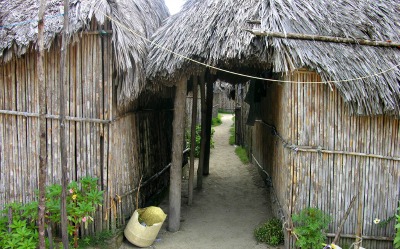
As these 2 photos show, the bamboo typically used to build homes in Panama is what is easily grown and harvested here. A fast-growing golden bamboo.
It is not the type of bamboo that North Americans think of as appropriate for construction. That is because it is not. These are not permanent structures. These homeowners know they will need to replace the bamboo in these small houses every few years.

However, sometimes a temporary building structure is just want you need.
We often use timber bamboo as temporary bracing or temporary fencing on our projects. I have made a couple of temporary sheds and a carport with it on our own property or in situations where I am “checking out” a design idea.
Since each 60’ length of timber bamboo costs about $1.50, it is a great, low cost, temporary building material. If it is protected from the sun and rain, the bamboo appears to last several years.
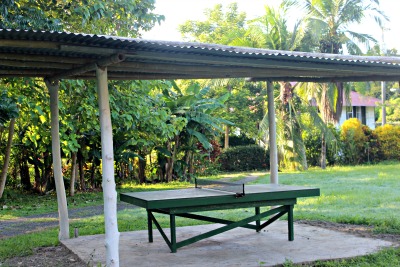
As you can see in the living room photo, we even use it in our own home. The bamboo you see in the photo is about 8 years old. We have replaced the bamboo on top of the zinc roof once in those 8 years. (Note: This open-air living room was added during the remodel, the rest of the house is 2 stories.)
I have seen photos online of beautiful bamboo structures in Costa Rica and other tropical countries.
In fact, I met a German man who has built a Bamboo house just over the border, on the beach in Costa Rica. I have yet to visit his project and find out more about it. I do know that he brought in a builder from a high-end area of Costa Rica who specializes in bamboo construction for expats. It is still on my “to do” list to visit his home and find out what strain of bamboo he used.

There are roughly 1500 known bamboo species on the planet. However, only a hand-full of them can be used for construction.
In Latin America, including Panama, the yellow striped bamboo, Bambusa vulgaris 'Vittata', is everywhere. Sadly, due to its hollow core, it cannot be used for construction.
The best construction-worthy bamboo grown in Latin America is the Guadua Angustifolia. Unfortunately, it is not a popular crop. Teak is much more popular.
People have been growing teak as an income-crop for many years. Until that changes, there likely won't be a much high-quality Guadua Bamboo available in Panama. Because there isn't much of this bamboo for sale, it will cost you more than you probably want to pay.
However, there seems to be sufficient Guadua Bamboo available in nearby Costa Rica (see Rudy's comment in the comment section).
Until it is more widely available in Panama, that may be a good option. You would have to investigate any import taxes you might have to pay to bring the bamboo over the border into Panama.
Of course, you can import the construction grade bamboo you need from various sources.
At least one of the sources I used to write this post (see below), offers to deliver construction grade bamboo to your building site in Panama. My guess is that cost of importing bamboo, relative to other construction materials, will be expensive. But it does seem worth checking out the cost.
The good thing is if more people want to build with Bamboo, more people will produce it, hopefully in Panama. This increase in supply will decrease the cost of bamboo.
Hopefully, building high-quality bamboo construction in Panama will stop being a luxury construction method.
With a greater supply of construction grade bamboo in Panama, bamboo can become an excellent way to build an attractive and affordable eco-friendly house.
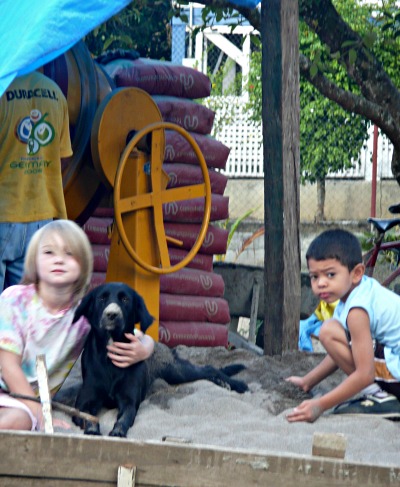
Which is why cement is the typical building material of all of Latin America.
It is also what we use as the primary construction material for our Living in Panama House.
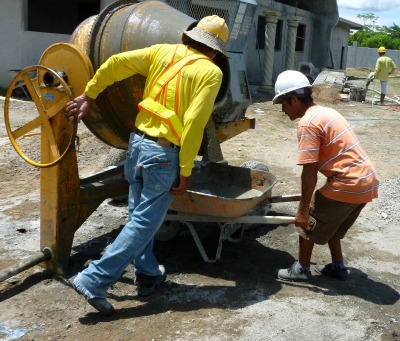
It is wise to keep your construction project within the comfort zone of the local workers. Builders in Panama are most comfortable working with concrete.
Think of Panama as a small town of 100 years ago, where folks are used to doing things the same way, generation after generation. Of course, they can learn new ways, but it won't be a fast, easy, or necessarily successful process.
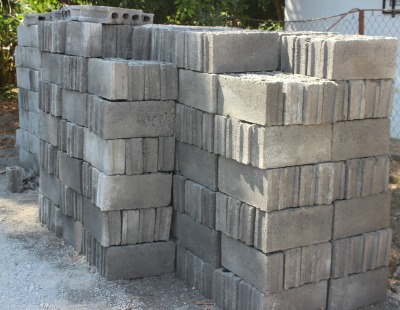
Concrete block is the most common method of construction. It is usually reinforced with steel rebar and the hollow cells in the blocks are filled with a concrete slurry.
Standard concrete blocks are 16” long and are available in 4” and 6” thicknesses.
Half blocks may be purchased to maintain the overlapping rhythm of the block structure. Block may easily be cut with a grinder, or scored and broken to size. (This is the most common method both in Panama and in North America).
As I mention in another article on hardware stores, the quality of block available in Puerto Armuelles varies greatly from supplier to supplier, and even between batches from the same supplier. You need to inspect each shipment, and even every block. Some blocks literally fall apart in your hands, while others are perfectly adequate, especially if you use plenty of steel reinforcement, and fill all cells with concrete.
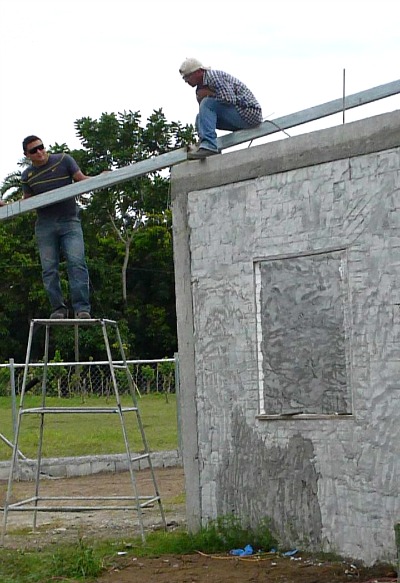
Please note: No block that I have encountered in Panama is of the high quality that one would encounter at a typical home center, or concrete supplier in the States or Canada.
However, I believe that in the very near future, as with everything else in Panama, the quality of local block will rise to the level of that in North America. The growth rate and improvements in quality in Panama are like nothing I have seen anywhere in my lifetime. The pace of growth and modernization in Panama is truly astounding.
Custom Blocks In Puerto
Our best block supplier has agreed to provide custom blocks using a higher ratio of cement to aggregates than his standard block. He will make it your specifications.
In other words, we can start getting that higher North American- quality block in Puerto Armuelles today.
M2 or Convintec is a insulated Styrofoam core panel covered with a galvanized steel mesh that is used
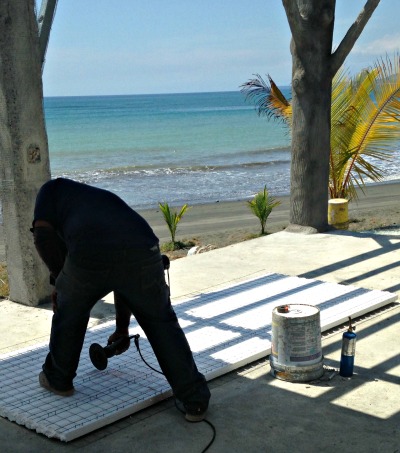
primarily for interior and exterior walls and sometimes for flooring or the roof.
M2 is used in place of concrete blocks, but must be “stucco coated” or "repello" with concrete.
M2 is increasingly popular and allows building to go up very quickly. Some people import higher quality M2 panels than are available in Panama. But most are successful using the locally available M2 panels.
M2 panels come in different thickness. Ideally, you should use panels at least 4 inches thick. Panels thinner than 4 inches have a tendency to buckle and are not load bearing.
Plycem is a fiber cement board widely used to replace wood siding, plywood, tile base in showers, and, at times, sheetrock. It can be cut, sanded, nailed, rough dressed, drilled and screwed with conventional woodworking tools.
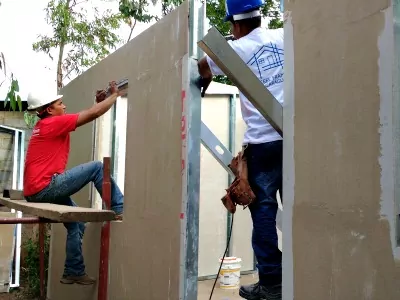
There is a similar product to Plycem available in the States. It is called Hardiboard.
Benefits of Plycem
Plycem is designed to be screwed into wood or steel studs and floor joists. 3/4 or 1" Plycem can even replace plywood floors, when placed on closely spaced floor framing using steel studs or wood.
In our own house, we have used Plycem as the base for a tiled kitchen floor as well as for the floor and walls of our bathrooms.
Thanks.
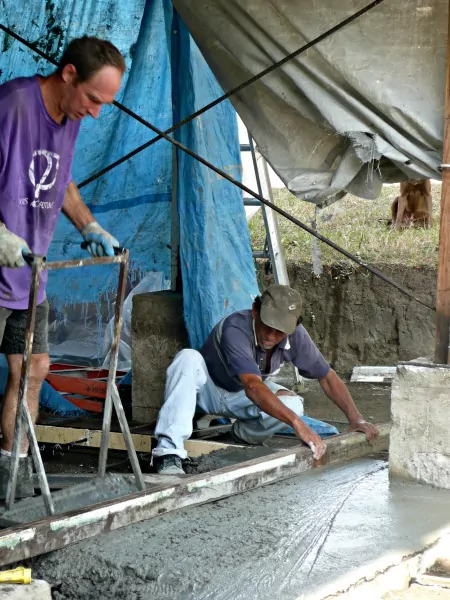
I wrote a post about each of these 4 building materials. The links to those posts are at the bottom of this page.
Whatever construction materials you use for your house, you need think about your choice carefully.
Hopefully, the answer is yes to all of the above questions. If not, make sure you are okay with the extra work and/or cost using your chosen material will entail.
One thing you should be careful about, is using building materials or construction techniques with which the local labor is unfamiliar.
If you get too innovative, you are likely to lose the locals along the way. Certainly, they will not be as interested in trying a new building experiment as you, the northern immigrant. You are in for a shock, if you came to Panama with ego-driven notions of how you would build, once you had moved to paradise, and with labor day rates that are less than half of what hourly rates are up north.
For some of us (I include myself here), this will require that we put our own ego in the “back seat." If you don't, you will face a lot of frustration, cost overruns, and disappointing results.
For me, after a long period of trying get the local builders to do things exactly, precisely my way, I have come to the conclusion that it is just not worth it. Believe me, I have tried it, many times (I am a slow learner). It just does not work. Or if it works, it is not a happy experience for anyone.
There are many wonderful things about the Panamanian people. When taken on their own merits, the people of Panama are kind, peaceful, genuinely warm neighbors, and happy to share their beautiful country with us. However, an intrinsic desire to learn something new, from foreigners no less, is not high on their priority list.
It is my opinion that we expats do best when we accept that fact. When we don’t try to impose our own perfectionism and rigid views upon the locals. Our own culture has certainly made plenty of mistakes, and continues to make mistakes and on a global scale.
Maybe we are being offered this opportunity to compromise a bit, to be less perfectionistic and judgmental . With this attitude well in mind, you can produce an interesting, good quality, project. A project that you can be proud of. And most importantly, you will build your house in a way that will not make enemies of your new Panamanian friends. Those relationships will be a joy for years to come.